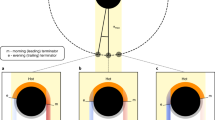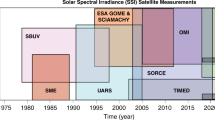Abstract
IN the course of taking submillimetre chromospheric data from Concorde 001 during the eclipse of June 30 (ref. 1), it proved possible to record information on the visual thickness of the chromosphere which is accurate enough to merit reporting. During an eclipse viewed conventionally from a stationary site on the ground, the precise time at which the solar photosphere reappears after totality, termed third contact, may be predicted to within 0.5 s (of time), given an adequate knowledge of the lunar limb topography, that is, to within 1 km in height at the appropriate point on the limb. Further, photometric measurements in white light could determine this time to within 0.3 s. It may also be possible from the ground, under ideal observing conditions, to see and measure emission from the chromosphere which should be visible in isolation for around 3 s, just prior to third contact. The predominant radiation seen during this time is that of the first line of the Balmer series, Hα, at 6,563 Å which accounts for the traditional description of the phenomenon as the ‘red flash’. It should be possible, after taking into account atmospheric scattering and diffraction effects, to measure the duration of this to within 0.5 s, though measurements of this type are not typically considered sufficiently accurate to be worth taking, when, for example, the flash spectrum of the chromosphere is also available2. Although various observers3,4 have studied the chromosphere spectrally in emission during eclipse, both just after second contact and just before third contact, inaccuracies in our knowledge of the precise orientation of the Moon and its topography have made absolute heights above the photosphere very difficult to measure to better than 300 km, although relative heights may be estimated to within 100 km under ideal seeing conditions. Similar restrictions due to seeing apply to estimates based on Hα filtergrams taken outside eclipse conditions5.
This is a preview of subscription content, access via your institution
Access options
Subscribe to this journal
Receive 51 print issues and online access
$199.00 per year
only $3.90 per issue
Buy this article
- Purchase on Springer Link
- Instant access to full article PDF
Prices may be subject to local taxes which are calculated during checkout
Similar content being viewed by others
References
Beckman, J. E., Begot, J., Charvin, P., Hall, D., Lena, P., Soufflot, A., Liebenberg, D., and Wraight, P., Nature, 246, 72 (1973).
Thomas, R. N., and Athay, R. G., The Physics of the Chromosphere (Interscience, New York, 1961).
Cillie, G. G., and Menzel, D. H., Harvard Obs. Circ., No. 410 (1935).
Suemoto, Z., Trans. IAU, 11 B, 206 (1962).
Loughhead, R. E., Solar Phys., 10, 71 (1969).
Dunn, R. B., Bull. Am. astr. Soc., 3, 267 (1971).
Beckers, J. M., Solar Phys., 3, 367 (1968).
Krat, V. A., and Krat, T. U., Solar Phys., 17, 355 (1971).
Athay, R. G., The Solar Spectrum (edit. by de Jager, C.), 151 (Reidel, Dordrecht, 1963).
Author information
Authors and Affiliations
Rights and permissions
About this article
Cite this article
BECKMAN, J. Visual Determination of the Mean Effective Chromospheric Thickness. Nature 246, 411–412 (1973). https://doi.org/10.1038/246411a0
Received:
Issue Date:
DOI: https://doi.org/10.1038/246411a0
Comments
By submitting a comment you agree to abide by our Terms and Community Guidelines. If you find something abusive or that does not comply with our terms or guidelines please flag it as inappropriate.



